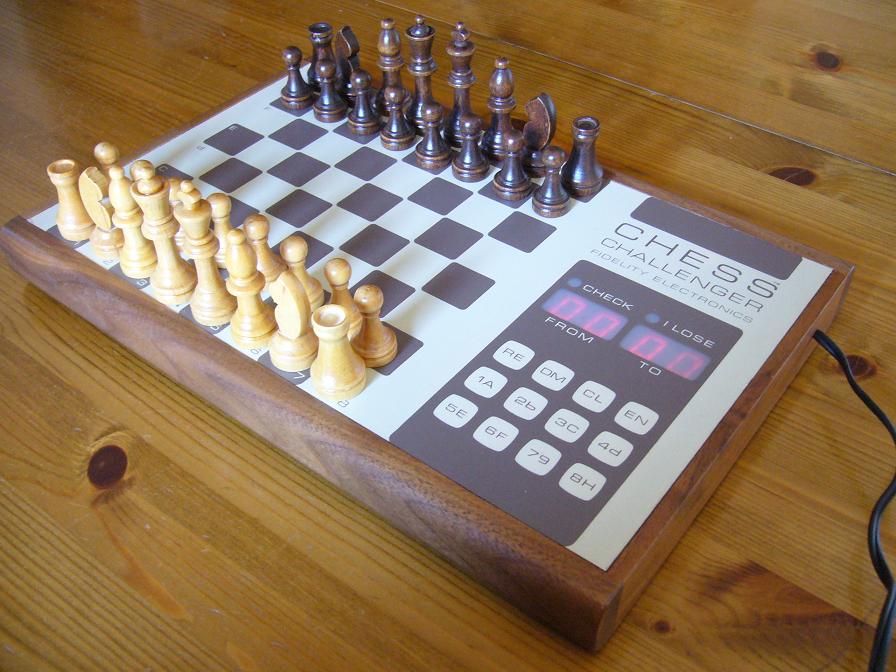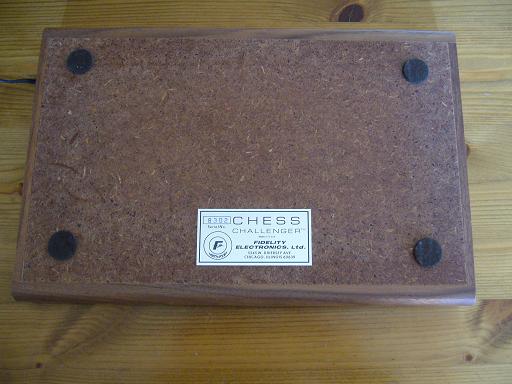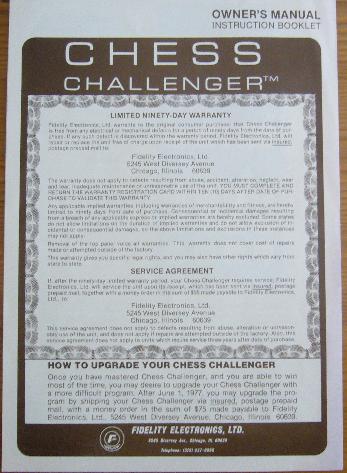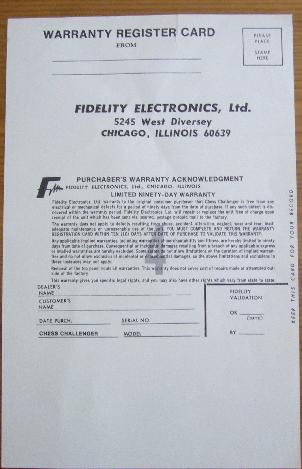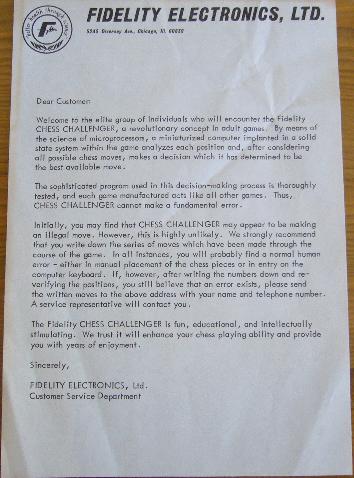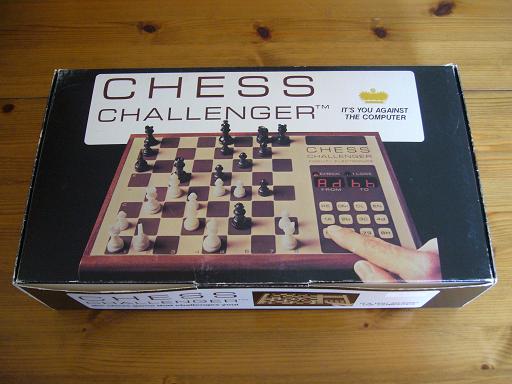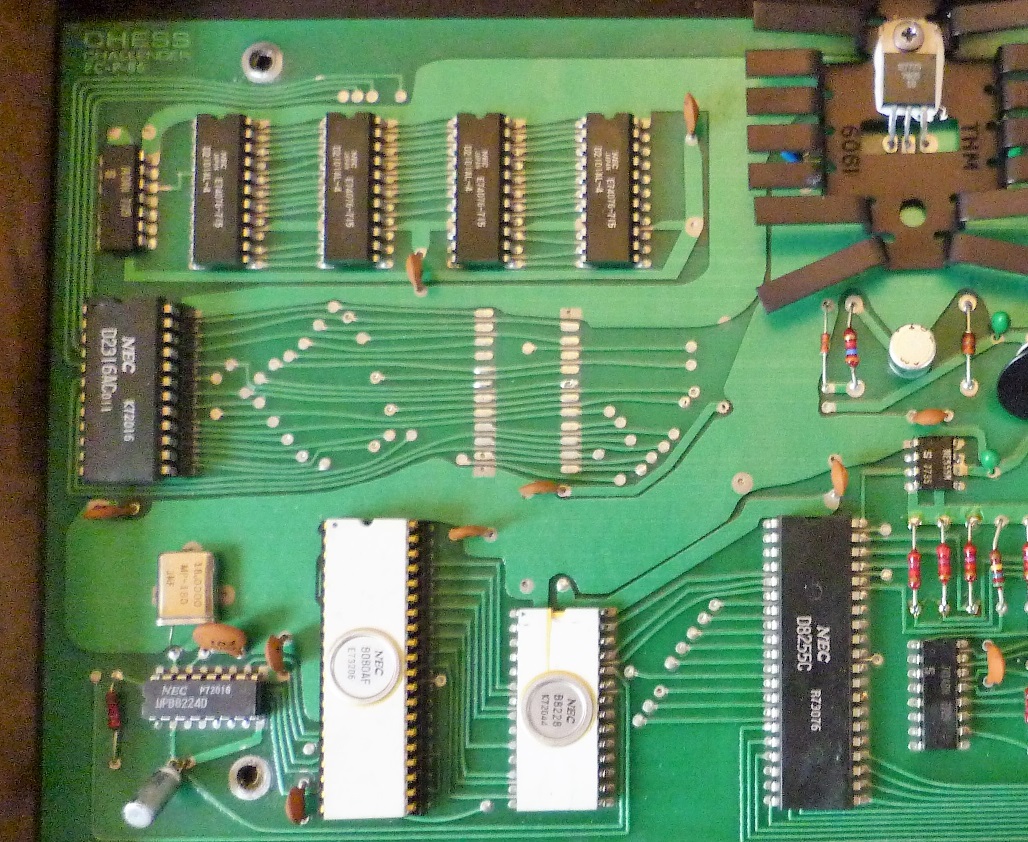|
How many CC1s survive today?
1000 CC1s were built according to Sid and Shane Samole.
Although quite a few chess computer enthusiasts have one (see Serial Number list below) I would still describe the CC1 as a rare chess computer. The flawed implementation and hardware faults resulted in many Chess Challengers being returned to retailers. In todays language the CC1 was not fit for purpose. You get the picture from the first paragraph of this Computer Chess Digest 1984 article by Steven Schwartz “Pity The Poor Chess Computer Buyer” (link). Retailers would have returned rejected and unsold stock to Fidelity, who in turn would have upgraded it. The offer to upgrade at a cost of another $75 must have been received as a dubious privilege by many individual customers, and I cannot envisage that a high percentage of them took advantage of it.
The evidence of upgraded CC1s is seen in the Chess Challenger boxes with the red “Three Levels of Play” sticker (see above). I have one such CC3 and have seen plenty of others on the internet, including several on Ebay. I also know of one CC1 which was upgraded to a CC3, and that in turn was upgraded to a CC10C. Of course most of the boxes with the red sticker would not have survived three decades so there will be many times more upgraded Chess Challengers than there are red stickers. Nevertheless the upgraded Chess Challenger could be almost as rare (though not as valuable) as the original.
Let us assume that one third of CC1s were returned by retailers and 10% of sold machines were upgraded. That leaves us with 600 CC1s. I know that Steffen Scholz has been told by an ex-Fidelity employee that 75% of CC1s were upgraded, leaving only 250. Let us assume for now that the non-upgraded number lies in the range of 250 to 600.
What happened to these? Some would soon have been thrown away as a purchasing mistake best disposed of. However a large majority would probably have gone into storage in American closets, attics and basements. A useless, but interesting and expensive piece of junk. These CC1s would have had to survive three decades of storage to still be around today. House moves and clear outs in the 1980s and 1990s will surely have led to many casualties. Hardware faults such as the tendency for LED display segments to disappear will have increased the casualty list. As time went on the CC1s will have been seen more as worthless junk than interesting. That is until the revival of interest in dedicated chess computers in recent years. My estimate of the ones that have made it to 2008 in working condition is one half, that is 125 to 300.
The advent of Ebay has made a great difference to those interested in collecting. In the last three years there has been a steady flow of CC1s appearing on Ebay USA. I have taken an interest in these sales for five years and have records of 28 genuine CC1 Ebay sales. One would normally expect only a small percentage of a chess computer model to appear on Ebay, but the CC1 is a special case. Prices up to £800 have been obtained, though £300-400 was the average until a recent fall in prices. So the CC1 is an item with very little utility but plenty of rarity value, the type of item which most encourages individuals to sell on Ebay. I expect the current 5-10 Ebay sales a year to continue for a while (written in 2008).
Many chess computer enthusiasts with a collection want a CC1. It is an historic model. Lengthy posts about Fidelity manufacturing and serial numbers on Kurt Kispert’s Forum by Karsten Bauermeister and Steffen Scholz, which included a list of 14 CC1 owners, led me to maintain a running list. From time to time it has been posted on Ismenio Sousa’s Message Board. This is the updated list (mid 2022) with the serial numbers and last known owner of each CC1 :-
1002 Ebay ID “crusaderwoppy” (USA)
1171 Dick Schneiders (USA)
1557 Ebay ID “seanh2001” (USA)
1668 “ultimategeek” (USA)
1827 Luis Barona Boj (Spain)
2271 sold on Ebay by ‘miers04’ 19/02/2016
2367 GaŽtan Vignola (France)
2428 Jose Antonio Ortigueira Amor (Spain)
2925 Alain Zanchetta (France)
2989 sold on Ebay by “exist-like-a-rainbow” 27/02/2016
3116 sold on Ebay by ‘sentinel1964’ 14/10/2013
3223 sold on Ebay by “414lou” 01/07/2013
3980 sold on Ebay by “mattquinley” 07/03/2021
4835 Maurice Ohayon (USA)
4981 Jose Antonio Ortigueira Amor (Spain)
5432 Wolfgang Rausch (Germany)
5580 Karsten Bauermeister (Germany)
6436 sold on Ebay by ‘phwert’ 07/10/2016
6506 Steve Blincoe (USA)
6620 Kurt Kispert (Austria)
6871 Gerardo Mateo (Spain)
6875 Karsten Bauermeister (Niggemann Museum) (Germany)
6939 Alan Cooper (UK)
6971 Ebay ID “simoncccccc”(UK) on sale 12/02/2019
6979 Ebay ID “bcfzambia” (UK) sold 08/12/2011
7040 “meran” (Canada)
7463 Hans van Meirlo (Netherlands) -> sold on Ebay 26/10/2014
7765 Gorgon Haas
8206 Karsten Bauermeister (Germany)
8302 Mike Watters (UK)
8666 Ebay ID “simoncccccc” (UK) sold April 2023
9626 Fabrice Di Meglio (USA)
9629 JPT (UK)
9639 Maurice Ohayon (USA)
11435 Chris Tatham (UK)
11744 Steffen Scholz (Germany)
11816 Ebay ID “moe7795” (USA) sold 11/10/2012
12113 Ebay ID “phwert” (Germany) sold 23/05/2010
12140 Ismenio Sousa (USA)
12315 the late Tom Luif (Netherlands)
12409 Mark Parsons (UK)
12412 “zman1110” Ebay sold 25/09/2020 ($330)
12459 Luuk Hofman (Netherlands)
12541 Maurice Ohayon (USA)
12839 Mike Watters (UK) - parts salvaged from non-repairable CC1
13124 Heinz Nixdorf
13659 Luis Barona Boj (Spain)
14265 Manfred Vellmer (Germany)
15234 sold on eBay by Luis Barona Boj (Spain)(15/03/2009)
16533 Dick Schneiders (USA)
16599 Lawrence Novak (USA)
16977 Eric Van Baars (Netherlands?)
20108 Ebay ID “haff2haveit” (USA) sold 20/06/2011
20137 Axel Schumacher (Germany) sold Ebay 22/01/2012
21010 “3214garage” (USA) on Ebay 05/04/2017
21490 Eric Belot (France)
21752 David Thompson (UK)
22516 Volker Lehnert (Germany)
22521 “fornaxx” (Germany)
22604 “spacious mind” (USA)
22754 “loudo1952” (USA) sold Ebay 23/05/2015
22854 Luuk Hofman (Netherlands)
22927 Nick Milicev (USA)
23143 Manfred Vellmer (Germany)
23490 “proto57” (USA) sold Ebay 10/07/2020 ($500)
23558 “keckteh” (Spain)
23743 “spacious_mind”(USA)
24290 Richard SantaColoma (USA)
27479 “unicornjockey” (USA) sold Ebay 29/12/2020 (non working)
27566 Manfred Vellmer (Germany)
29471 Computer History Museum (USA - https://www.computerhistory.org/collections/catalog/102677121)
29666 offered on Ebay by ‘famousamos*amy’ February 2016
29683 Larry Harper (Australia)
29784 ‘Russ’ Salt Lake City (USA)
30409 Steffen Scholz (Germany) --> Alan Cooper (UK)
30499 Jim Davis (USA) sold on Ebay 28/04/2009
32132 Mike Watters (UK)
32598 Jose Antonio Ortigueira Amor (Spain)
36684 sold on Ebay by ‘miekefix’ 09/12/2015
36746 “dulce_simon” (Spain)
852194? Alwin Gruber (Germany)
Ebay sales with serial numbers unknown - “katzekatze”(08/02/2004), “brettschachcomputer”(07/06/2005), Christian Mueller (Germany)(sold 18/11/2012), “vitamin_zen”(19/02/2006), John Diego (USA)(30/08/2006), “spacious_mind” (USA)(04/10/2006), GaŽtan Vignola (27/03/2008), “nav-san”(16/07/2008), “2768janice” (USA)(16/03/2009), “superduty455” (USA)(18/01/2012), “jaxyard” (USA)(08/07/2011), “countrylane” (USA)0(6/06/2011), “amazinggrace778”(USA)(03/02/2013),”phay9999”(UK)(11/10/2014, ”delawarepickers”(USA)(27/07/2015), “cshiner09” (UK)(02/12/2020)
Total 102
Any additional information or corrections gratefully received.
.
|
